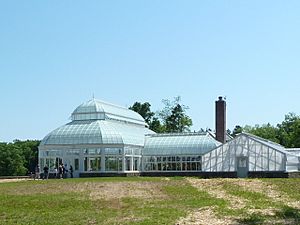Duke Farms facts for kids
Quick facts for kids Duke Farms |
|
|---|---|
| Raritan Valley Farm | |

The Farm Barn building, now the Orientation Center
|
|
| Lua error in Module:Location_map at line 420: attempt to index field 'wikibase' (a nil value). | |
| Type | Nature reserve, park |
| Location | Hillsborough, New Jersey |
| Nearest city | New Brunswick, New Jersey |
| Area | 2,700 acres (1,100 ha) (total) 343 acres (139 ha) (open to public) |
| Elevation | 98 feet (30 m) |
| Closed | Raritan Valley Farm: 1899 Duke Farms: 1915 |
| Founder | James Buchanan Duke |
| Designer | J.B. Duke Doris Duke |
| Operated by | Doris Duke Charitable Foundation |
| Open | Nov 1-Mar31: 8:30am-4:30pm Apr 1-Oct 31: 8:30am-6:00pm Closed Wednesdays |
| Status | Operational |
| Plants | see Duke Gardens for details |
| Parking | 365 spots |
Duke Farms is a large property in Hillsborough, New Jersey. It was created by James Buchanan Duke, a very successful American businessman. He started companies like Duke Power and the American Tobacco Company.
After James Duke's daughter, Doris Duke, passed away, the property was managed by the Doris Duke Charitable Foundation. Duke Farms opened to the public on May 19, 2012, after a big renovation.
Contents
History of Duke Farms
How Duke Farms Started
In 1893, James "Buck" Duke began buying land near the Raritan River in New Jersey. He wanted to build a farm that looked like the ones where he grew up in North Carolina. He hired many experts, including architects and engineers, to help him.
Eventually, he owned about 2,700 acres (11 square kilometers) of farmland and woods. This huge property included 45 buildings, 9 lakes, and 18 miles of roads. It also had 810 acres of woodlands and 464 acres of grassland for birds.
Doris Duke's Influence
James Duke died in 1925. His daughter, Doris Duke, was only 12 years old when she gained control of the property. She moved in at age fifteen and made Duke Farms her main home.
Doris Duke cared a lot about the property. She used new ways of farming that were good for the environment. Starting in 1958, she spent five years creating a special plant display. This was in the Horace Trumbauer conservatory and greenhouses. It became known as Duke Gardens. Duke Gardens opened to the public in 1964. Doris Duke died in 1993.
Duke Farms: A Park for Everyone
- Further information: Duke Gardens (New Jersey)
Duke Farms is now owned by the Duke Farms Foundation (DFF). This foundation was created in 1998 to manage the property. The DFF is part of the Doris Duke Charitable Foundation.
The foundation decided to make Duke Farms a great example of how to care for the environment. They wanted to teach visitors how to be good stewards of the land. While the property was being reorganized, it was mostly closed to the public.
Changes and Renovations
In 2008, the DFF made a big change. They permanently closed Duke Gardens and removed the indoor plant displays Doris Duke had created. Over time, the DFF built new indoor and outdoor gardens. These new gardens are eco-friendly and use plants that naturally grow in the area. They are also easy for people in wheelchairs to visit.
During the renovation, many foreign plants that spread too much were removed. These included Norwegian maple and Asian Ailanthus. They were replaced with native plants.
Duke Farms has some very old and special trees. Four of its trees are among the ten oldest in New Jersey. It also has two "champion trees," which are the largest of their kind. These include a Northern red oak and an Amur Cork Tree.
Opening to the Public
On May 19, 2012, Duke Farms officially opened to the public. The renovation cost $45 million. Now, Duke Farms is home to 30 endangered species and 230 types of birds. You might see great blue herons or even bald eagles there.
As part of the updates, the conservatory and greenhouses, called the Orchid Range, were improved. They now use less energy. The old Farm Barn building was also changed. It became the Orientation Center, where visitors can learn about the park.
In 2016, the mansion where Doris Duke lived was taken down. This was done to open up more of the property for visitors.
Gallery









